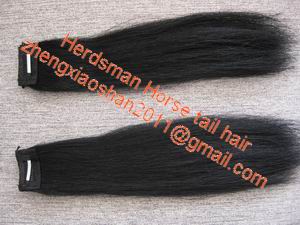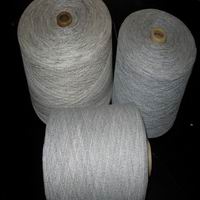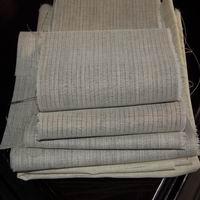Show Tails
With many sport horses, particularly in dressage, the carriage of the dock gives the judge information on how the horse is using his spine. Its best if a bush of hair doesnt obscure the dock, so the tradition has been to shorten the hair in this area. I like to see a smooth blend from short to long to longer and even longer, Harris says. I definitely dont like to see something we call a broom handle, where it looks like its been shaved close and then bushes out. If you watch a horse carry his tail in motion it sticks out for a few inches and then it makes a turn and goes down. Usually you want to thin the hair close at the point where it turns or breaks over and then gradually blend from there down.
Another way to finish a braided tail that is becoming popular is the wrap-around finish, in which the end of the braid is wrapped around the base of the dock (see Its a Wrap).
There are two ways to shorten the hair around the dock: hand pulling and shaving with clippers. Hand pulling is the traditional British way but it isnt great to do if the horses isnt keen because youre standing right behind his artillery! Harris says. Some horses dont mind, but if the horse tells you it hurts, you have to believe him. This technique works just like pulling a mane: Wrap the hair around the comb and jerk it out until you have shortened the hair to the desired length. Try to do a little at a time because you can always take off more but you cant put anything back! Harris says.
From time to time, lift the tail up in the carrying position to check your work. Its easy to get carried away and shorten the tail beyond that natural break. If I have a horse that likes to clamp his tail, I place a wooden twitch handle under the dock and that puts the tail in the right place, Harris says.
Sign up to get updates delivered straight to your inbox.
False tails are a lot of work, Harris says. You have to take care of it like you would a real tail, and you have to know how to apply it correctly. Application depends upon the type of wig you have. There are wraparounds, braid-ins and loop styles. Some breed associations ban lse steners, so you cant use a shoelace or wire, for example, to attach the wig. The stener has to be hair. Application directions will come with whatever tail wig you get. Practice at home a couple of times before you put it on at a show.
Many English disciplinesnotably dressage and eventingand even some western disciplines, bang the horses tail. Banging means to square the tail straight across at the bottom, so the very end of the skirt has a blunt edge. The length of banged tail is a matter of personal style, typically from fetlock height (anywhere within the fetlock) to the bottom of the hock, depending on what looks good on the horse, and current trend within the discipline. Fetlock height is a common preference.
HorseChannel takes your privacy seriously. To learn more, please read our privacy policy.
However, clipping the top of the tail is more common and certainly easier and safer. Look underneath your horses tail and youll notice a bald v-shaped spot. What youre trying to do is make that v-shape bigger. Start the process by shortening the hair on the sides of the tail, running the clippers in the same direction of the hair, blending carefully so no hairs are bushing out. During show season, youll have to keep running the clippers over that spot because the hair will grow out bristly. Keep stepping back to make sure both sides are even. You dont want one side bald and the other bushy.
Susan E. Harris, Centered Riding instructor and author of the perennial vorite and soon to be updated classic, Grooming to Win, says that regardless of your horses discipline, a long, full tail is a healthy tail. And no matter how many grooming products you use, growth ultimately comes from good nutrition. Another way to get that full tail is by preserving the long hairs your horse already has. It can take three to seven years for one hair to grow from the tip of the dock down to the fetlock, Harris says. So prevent those hairs from breaking off. Wherever your horse spends his time, be mindful of any objects or places where he can catch his tail. Think twice before putting your horse in a stall with splintered wood; or in a pasture or paddock where there are burdocks; or turned out with weaned foals, goats, calves or chronic tail chewers.
To bang the tail, have an assistant hold the tail up to where the horse would carry it in motion. Then slide your hand around the tail and down to the end of the skirt, just above where you want to cut. What method you use to cut the hair is your choice, but the easiest way to square the end is with clippers. Scissors can be hard to cut all the hair in one piece and the hair can slip and move, so youll have to stand back to check your work to make sure the cut is level. You might have to make more than one cut. Clipper blades are squared off so cutting a straight edge is easy. Hold all the hair together and run the clippers across the bottom.
Tail wigs became popular in the 1990s, and they are common in many arenas, in particular the western show pen, where big hair is definitely in style. Some disciplines and breeds ban tail wigs, so be sure to consult your rulebook for your breed and discipline to check whether lse hair is banned. If your breed does allow it, a lse tail can help a sad tail look great.
There are a few rules of thumb regarding tail banging. Although banging the tail is most common with sport horses, the practice isnt universal. The trend comes and goes with these horses, Harris says, so ask around or visit a competition to see whats in at the moment. Also, if your horse has a wispy tail, then banging it will make it look silly. So its best to keep a natural tail in this circumstance. Interestingly, western divisions have been embracing the squared off tail in many events. For western horses, the shion is to square the tail off a couple inches above the ground.
Anytime you brush your horses tail you cant help but pull out hairs. Harris says you can get the shavings and snarls out without vigorous brushing. Never rake a grooming tool through the tail, she says. Every clump of hair on the barn floor will take forever to grow back. Instead, spray the horses tail with a silicone coat spray. Silicone bonds to and smoothes each individual hair. (However, never use it on hair youre planning to braid because the plait will slip out.) When the spray dries, the hairs will be slippery and you can easily shake or hand pick the debris out of the tail. If you really want a little help, you can carefully use a smooth, wide-toothed nylon comb. But you have to use it gently to separate the hairs of the snarl. Fingers are the best tools with snarls.
You can then choose to leave the tail hair long on top of the dock or you can continue,horse hair jewelry carefully and judiciously, clipping in the same direction as the hair growth (just the hair that sticks up into the clipper blades), to the point where the tail breaks over, blending as you go.
Braided tails are generally sported by show hunters, foxhunters and hunter equitation riders. In equitation you want your horse and rider perfectly turned out, Harris says, noting that even when not required, braiding is a good idea because equitation is a little formal. For show hunters, she says, A braided tail shows off how a horse uses himself over a line of fences. So if he has a beautiful bascule and carries his tail well, it shows him off.
There are a variety of ways to finish off the braid. For a quick and easy ending, use a rubber band: As you get to the end of the dock, braid down in a regular braid four to six inches into the tail skirt. Crimp the end of the braid and bind it with a rubber band, creating a knobthere will be a switch of unbraided hair hanging down. Flip the knob under and, with your fingers, poke the knob up into the body of the braid. All the extra hair will get lost in the skirt of the tail. Put another rubber band around the base of the hanging plait. You will be left with a small hunter-style braid, similar to what youd put in the mane. When you want to take the braid out, find the loose hairs, tug, and the rubber bands will pop off and the braid will come out.
Trends come and go, but it all begins with a beautifully kept, clean, free natural tail. If you start with that you can modify the tail a little or a lot, Harris says.
Sharon Biggs is a frequent contributor to Horse Illustrated and a dressage instructor. She is the author of In One Arena (Half Halt Press) and the soon-to-be-released Advanced English Horsemanship (BowTie Press).
Tails are generally braided in a French braid. (Note: If you want to braid, do not pull the tail.) Refrain from using a coat dressing, which will make the tail hairs too slippery to braid. With a French braid, the idea is to incorporate hair from the sides of the tail into a central braid in the middle of the dock. (See diagram below.) Try to make the pieces even on both sides as you work your way down, with just a small amount of hair added each time so the braid doesnt get too bulky.
We all know that appearance should be secondary to performance, but looks do have an effect on first impressions. Research in humans has found that the first impression is made in three seconds. With such little time to make your preliminary mark, youd better pull out all the stops in the show-ring. The grooming of your horses tail speaks volumes. It tells the judge whether you understand the particular grooming traditions within your discipline, whether youve paid attention to every tiny detail, and it shows that you have respect for the judge and the competition. Also, in some disciplines, such as dressage, judges watch tail carriage to see if the horses back is relaxed. Since tails are on show so much, a beautifully groomed one can score a rider much-needed brownie points.
The pinwheel is traditional and stylish. To make a pinwheel, braid all the way down to the end of the skirt, using a very small amount of hair (a thick braid will make a huge Princess Leia bun). Braid in two long pieces of thread, the same color of the tail. As you get to the end of the tail, thread a needle through the braiding thread. Begin to coil the braid up, creating a pinwheel as you go. Take a stitch through, each turn you make. When the entire braid has been coiled up, sew the pinwheel to the French braid.

If you have a horse with a very thick tail, false horse tails you can start at the bottom of the skirt and work upward, combing carefully or hand-picking down into the hairs already groomed and detangled. A snarl is also easier to work out from the bottom to the top. If you start at the top of the snarl, you will only make the snarl tighter and cause hairs to break and ll out.
If you cant change your horses hangouts, you can protect his tail in a braid or with a tail bag. But make sure it is appropriate for your horses situation. Certainly leave these off in summer during fly season, Harris says. I dont like to see a horse whacking himself with a tail bag, himself miserable. So if you dont show very much, let the horse have a natural tail.
Matching the color of your horses tail hair and selecting an appropriate thickness are also key to king it successfully.
查看相关产品:












